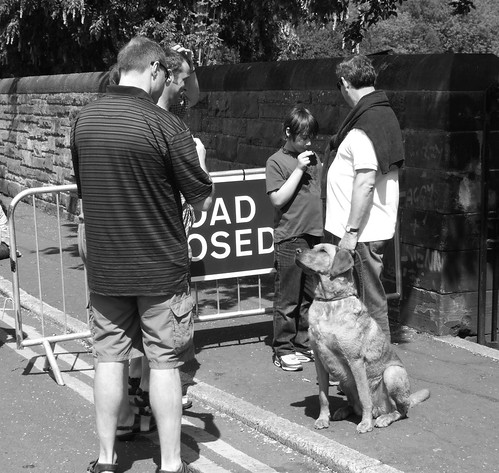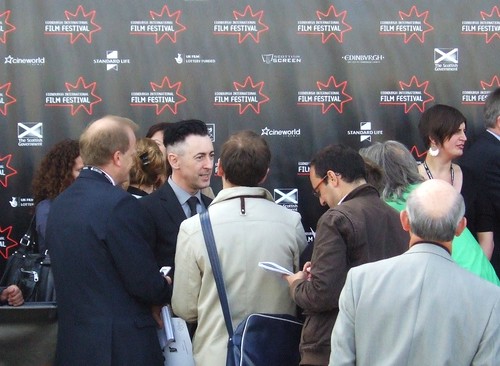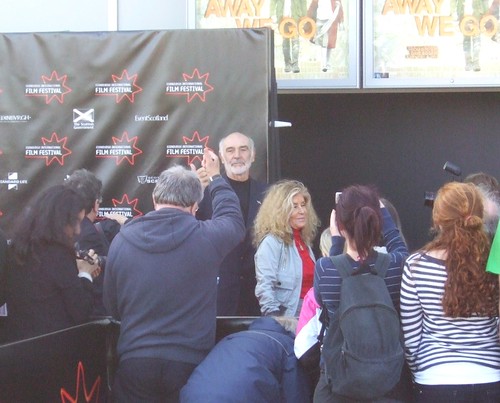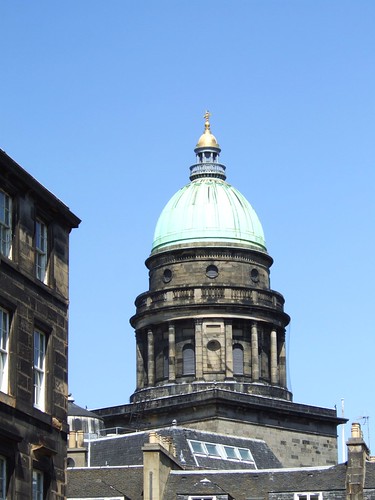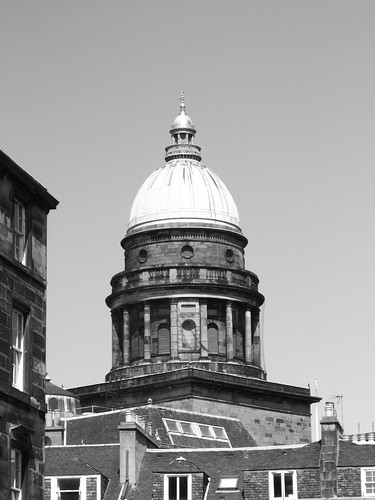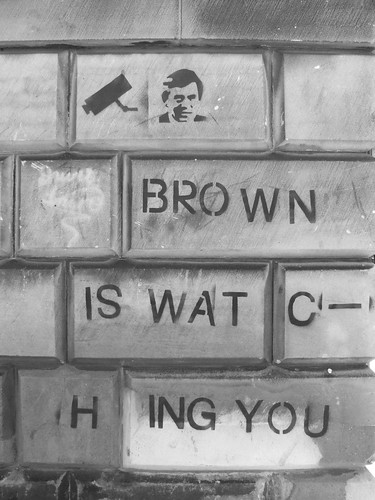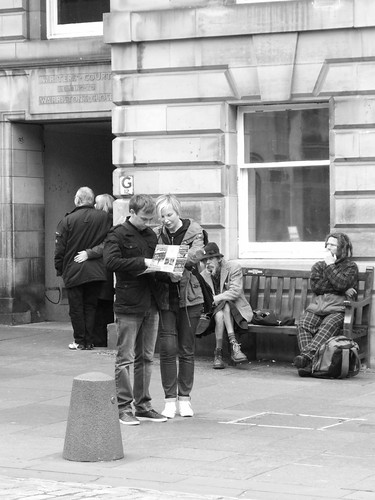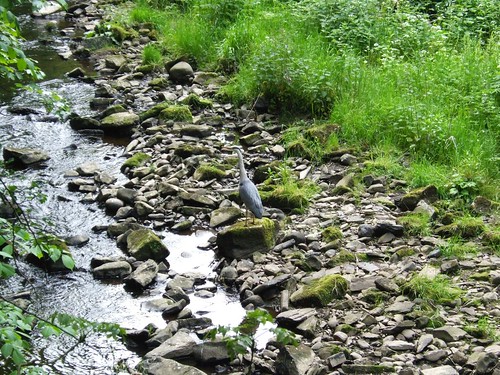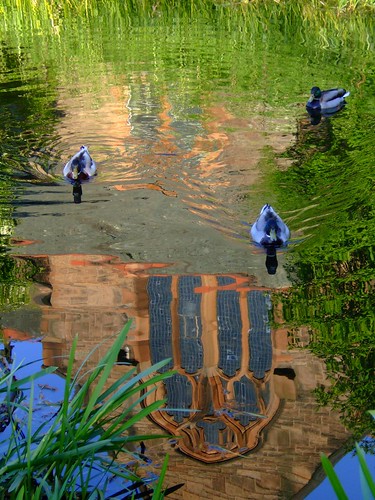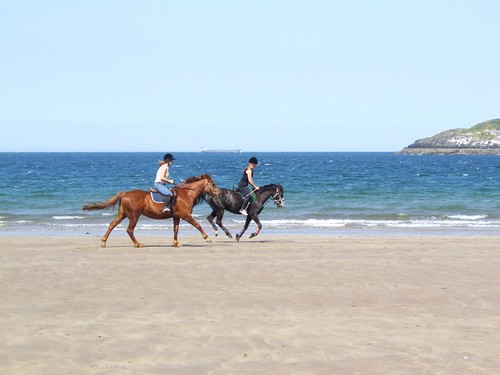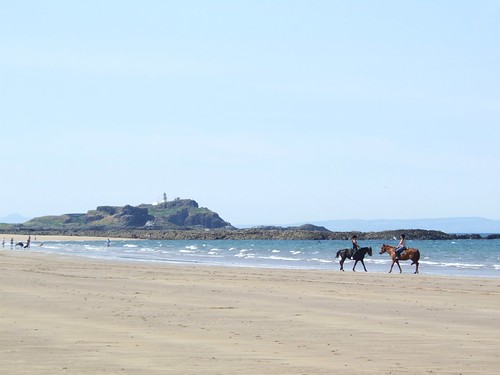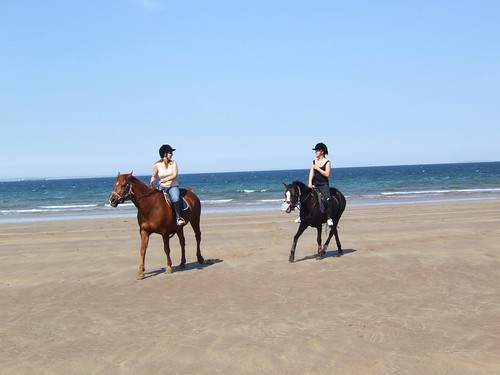Among the movies I was eager to see during my annual week off at this year’s Edinburgh International Film Festival were two animated features which we’ve mentioned on here before (regular readers will know of my fascination for all forms of animation) - the Australian stop-motion film Mary and Max (that rare thing, a feature length, independent animated movie aimed at an older audience) and a more traditionally animated 2D offering from Ireland’s Cartoon Salon, The Secret of Kells, which was created primarily for a younger audience.

(an illuminated text version of Aisling and Brendan)
Regular readers will probably remember me mentioning this rather beautiful Irish animation a few times before on the blog - artist Cliodhna Lyons (Irish 24 hour comics day) first put me on to it last year as she had been involved with the Cartoon Salon in Kilkenny and the descriptions and artwork I saw had me hooked. It is an Irish-French-Belgian production and this and the graphic novel based on the film meant Kells also had a presence at this year’s prestigious Angouleme Festival, which Wim covered back in January. Drawing (no pun intended) inspiration from the fabled Book of Kells, one of the incomparably beautiful books in the history of world literature, The Secret of Kells offers up the tale of a young monk, Brendan, a novice at the monastery of Kells where his uncle is the stern, towering, grim-face abbot.
It is an evil time for many - Rome is but a distant memory and the Dark Ages have fallen across much of Europe. One of the lights in the long, dark night comes from the early church and most especially in the monastery’s preservation and dissemination of learning and the dim, early days before nations like Ireland and Scotland were actually nations, but were slowly being forged in a cauldron of oral myth, the unique Celtic brand of Christianity, small kingdoms becoming larger kingdoms and the testing by fire of brutal events like the seemingly endless invasions of the Norsemen - the Vikings. Off the Western coast of Scotland, among the many islands which scatter there though the seas lies the spiritual home of early Scottish Christianity and it is from here that Brother Aidan must flee as the Viking raiders sack this sacred site and slaughter or enslave the holy men who live there, destroying or ransacking everything within. Aidan flees with a remarkable book, the Book of Iona, still to be completed after many long decades of patient illumination by many gifted, scholarly monks. Bringing it to Kells he hopes to complete it with the help of brothers in the scriptorium there, but the abbot has lost patience with such things, being totally obsessed with building walls and defences against the inevitable Norse assault he knows will come on Kells and the monks and many villagers who have fled there for protection. He actively discourages his young nephew from helping Aidan, who, now finding his old hands to unsteady for the job, seeks a gifted replacement to finish the book.
Disobeying his uncle Brendan steals into the forest, a dark place, home to strange creatures from Irish folklore, dark wolves, standing stones, strange caves, home to mythical beings. And a forest sprite in the form of a young girl (Aisling), who is suspicious at first but soon warms to Brendan until the two become close friends.

The film is beautifully animated - the artwork is often simply gorgeous, as befits a work inspired by one of the most beautiful cultural treasures in the world. Sometimes the characters appear to be walking in an odd way compared to the background and it felt to me that this was a deliberate style adopted by the animators; its as if the characters are flat and walking across a flat background, which seems appropriate to the art style of the period, long before the more normal (to us) adoption of perspective in Renaissance art much later. Some scenes are also broken into split screens, little triptychs which recall the lovely, large header illustrations common in many illuminated books of the period, while other scenes again draw directly for their design on the unique form of illuminated texts which the Celtic school of Christianity created, people, animals, beautiful plants, flowing script and twisting, interwoven lines and knots combining into something so beautiful it almost makes you cry (so beautiful its mere sight is supposed to blind sinners as Brendan says), while other touches are small and subtle, such as the way the dappled light sparkles in the forest as the sun comes through the leaves.
Contrasted against this the Norsemen are depicted mostly in shadows, dark black and blood red outlines of hulking figures, swords and horns, recalling the demon from Fantasia (for which the great Bela Lugosi posed for the Disney animators, long before motion capture). Their acts, while never shown in detail, are brutal, dark, terrifying - for a film aimed primarily at younger viewers possibly a bit scary, but then they should be and I think its good that the animators don’t hide the horrible brutality of the period, especially as it makes the book stand out all the more. Too late the abbot will realise that his endless obsession with defences will still not halt the tide of Viking onslaught and that while they are all transient beings the book is more important then any of them or the abbey itself; the book is a symbol of the light, a beacon to shine a path out of the Dark Ages and to touch the souls of men and women for eternity (as it still does to this day). But only if Brendan and Aidan, with help from Aisling and a rather smart cat can save this remarkable work of art.

(the demonic Norsemen attack)
Its an utterly beautiful film - there’s a lovely adventure and a tale of friendship, of learned responsibilities, of what is most important, of coming of age, of saving what you can against the ages, served with a helping of folklore and fantasy, some humour and some wonderful moments of wonder that will have the eyes of child audiences open wide and the eyes of the adults too, all served up with some beautiful, traditional animation, which moves from the reasonably simple to the gorgeously elaborate scenes directly inspired by the Book of Kells. And as a bonus hopefully it will inspire kids to learn more about our history and our shared culture. Sadly there is still no news on a general UK release as yet, so at the moment you will need to watch out for it at film festivals. Which is a huge hint to any film distributors out there - this is beautiful, enchanting adventure with soul and culture and it needs to be seen by more people (and parents its a perfect one to take your kids to). And its not just animation lovers like me - Secret of Kells took the much vaunted Standard Life Audience Choice Award at the Edinburgh Film Festival - that’s an award cast by actual audience members as they leave the cinema, not an award given by critics, so obviously the audiences here loved it too; you can find out more on the official movie site here and director Tomm Moore's blog.
(director Tomm Moore - pictured centre - at the UK premiere during the Edinburgh Film Festival, from my Flickr stream)
Also at the Film Festival I was lucky enough to catch another animated film I have been eager to see for months, Mary and Max. The first Australian film every picked to open the prestigious Sundance Festival and also the first animated film to do so (which is a strong indicator of how good it is, as is its award at Annecy), its one of those movies which has been gathering impressive word of mouth on the international festival circuit, although like all indy films that is only half the struggle - getting general releases in various countries is another matter and good showings at film festivals is part of that hard slog of getting the film seen by a wider audience (a task made harder by the fact its an animated movie made for adults - most film companies won‘t know how to market such a thing). And does Mary and Max deserve to be seen by that wider audience? Oh yes, without a doubt yes.
(Max Jerry Horowitz from Mary and Max)
This lovely, stop-motion tale is essentially a story of two damaged, lonely souls who find a remarkable connection across the world. Young Mary is a little girl in suburban Australia, with no friends at school, a funny looking face that gets made fun of, a father who spends most of his time on his hobby of taxidermy (using roadkill for subject matter) and a mother in hair rollers, hideous glasses and constant alcoholic and smoking fugue. It’s a lonely upbringing and Mary escapes into imagination and her love of chocolate and the animated show Nibblets. One day while her mother shoplifts items from the local post office Mary leafs through an international phone book, wondering at the ‘strange’ names in an American directory. On an impulse she decides to take down the details of one random name and write him a letter to ask about life in America.
Max is a middle-aged, obese Jewish man living in 70s New York, also a lonely, damaged soul (as we find out later, he has Asperger’s, which is one reason he has difficulty in relating to people until Mary writes to him), flitting between a succession of jobs, a number of fish (which keep dying and being replaced) and trips to Overeater’s Anonymous which are rather defeated by his love of chocolate. He is quite surprised to receive Mary’s letter, complete with some samples of chocolates from Australia and very soon they are swapping letters, chocolates and little bits of their isolated lives to something neither had before - a friend. It’s at this point that the situation could be seen as straying into potential landmine territory - lonely young girl corresponding with isolated, lonely older man? You can almost imagine a red-top tabloid screaming headline now. But it isn’t like that. Somehow these two damaged souls have found what they needed, a friend, and an unlikely relationship blossoms before, inevitably, hitting some more stormy seas, not least when a more grown up Mary, now at college, studies psychology and uses Max as her main subject.
The film doesn’t try to hide the shortcomings of the characters any more than it tries to wallow in sentiment - it simply presents them and the many little facets of growing up and life that everyone can identify with, from finding out the illicit pleasures as a child of sneaking a tin of sweetened condensed milk to the shattering implications of a dear friendship being damaged (and also presents Aspergers with some sensitive understanding). It’s often funny, sometimes quite sad, but even when sad it is that beautiful kind of sadness that draws you in. The animation is all done in stop-motion and looks wonderful. I have no problem with CG animation but there is something I always find fascinating about stop-motion, the fact that, as the producer (who did a Q&A after the screening) remarked, everything you see on the screen was there, it was all designed, built and then painstakingly moved by hand, frame by frame; its all real, every item you see on screen was touched by a person putting life into it.

(Mary Daisy Dinkle wrapping up another package for her pen friend)
The voice talent boasts Toni Collette and Philip Seymour Hoffman, both agreeing to work for a fraction of their normal movie fees simply for the love of it (another indicator of how good this film is) and the narration comes from none other than the great Barry Humphries, who apparently they were huge fans of and terrified to meet, but he was charming and agreed to do it, even if he noticed Mary’s mother had a slight touch of the Dame Edna about her. It’s rare to see independent animation features and even rarer to see one aimed at an adult audience (although I think it’s also quite suitable for a YA audience too). There’s more than a touch of the Edward Gorey (or his modern heir, Tim Burton) to some of the style and humour, not so much Gothic but in the dark humour that life often throws up. What can I say except I absolutely loved it and, like the Secret of Kells, I hope that some film distributors pick it up and give it a proper general release here. Meantime, if you see it on the programme of a film festival near you, take my tip and go and see it.


